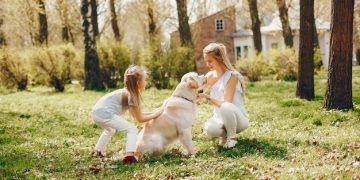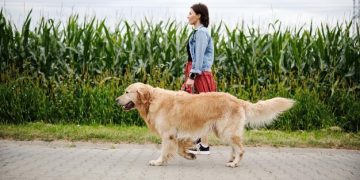Dog Park Etiquette: Train Your Dog for Safe & Social Playdates
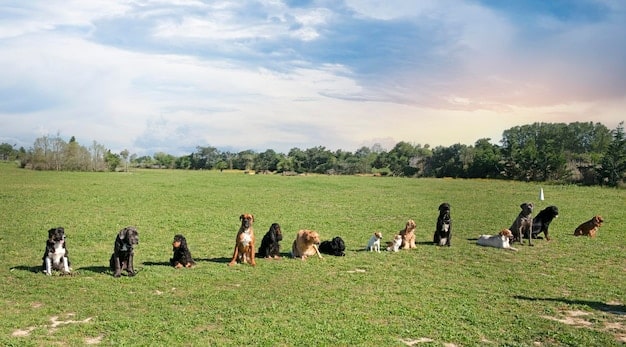
Anúncios
Dog park etiquette involves understanding and adhering to a set of rules and guidelines that ensure the safety and enjoyment of all dogs and their owners, including proper training and socialization for positive interactions.
Dog parks are amazing places for our furry friends to socialize and expend energy, but they also demand a certain level of responsibility from dog owners. Understanding and practicing good dog park etiquette: train your dog for safe & social playdates, and this ensures a harmonious environment for everyone.
Anúncios
Understanding Dog Park Etiquette
Dog park etiquette might seem straightforward, but it’s more than just letting your dog run free. It’s about being a responsible pet owner and ensuring your dog’s behavior doesn’t negatively impact others. A well-managed dog park is a happy dog park.
Why Etiquette Matters
Etiquette in a dog park isn’t just about rules; it’s about creating a safe and enjoyable space. Knowing the basics of dog park behavior can prevent accidents and misunderstandings.
Anúncios
Basic Rules of Dog Park Etiquette
Before you ever step foot in a dog park, there are certain guidelines that every owner must know. These rules, while seemingly simple, are vital for overall safety.
- Ensure your dog is vaccinated and healthy.
- Always clean up after your dog.
- Supervise your dog’s interactions at all times.
- Keep your dog on a leash until inside the designated area.
Adhering to these basics reduces the risk of disease spread and minimizes aggressive behaviors.
Etiquette is essential for communal harmony. By following these guidelines, dog owners contribute to a positive and safe atmosphere.
Essential Pre-Park Training
Before even thinking about visiting a dog park, proper training is paramount. Training isn’t just about teaching basic commands; it’s about building a foundation for controlled behavior in distracting environments.
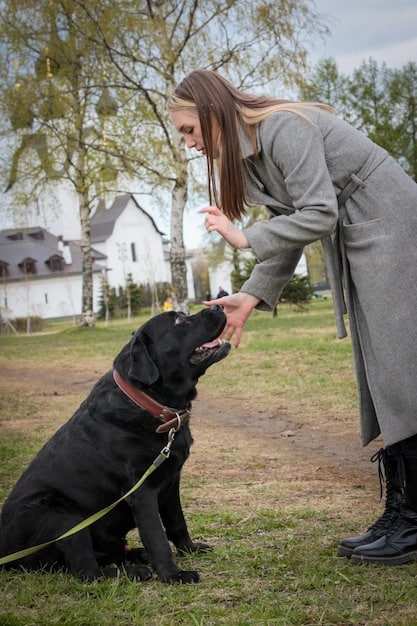
Mastering Basic Commands
Basic commands are the building blocks of good behavior. A reliable recall, sit, stay, and leave it command can be game-changers in a park setting.
The Importance of Recall
Recall is arguably the most important command. Being able to call your dog back, regardless of distractions, can prevent a number of potential problems from escalating.
- Start recall training in a low-distraction environment.
- Use positive reinforcement (treats, praise) when your dog responds.
- Gradually increase the level of distractions.
- Practice consistently and frequently.
An effective recall command can quickly remove your dog from potentially harmful situations.
With the firm base of common obedience, your dog is more likely to engage effectively with other dogs at the park.
Socialization: Preparing for Playdates
Socialization is critical for a dog’s well-being and their ability to interact appropriately with others. It’s not enough for your dog to simply tolerate other dogs; they need to be comfortable and confident around them.
Early Socialization
Early socialization, ideally during puppyhood, sets the stage for healthy social interactions later in life. Introducing your puppy to a variety of sights, sounds, and dogs can mitigate potential behavioral issues.
Controlled Introductions
Before throwing your dog into a full-blown playdate, start with controlled introductions. Supervised meetings with a calm, friendly dog can help gauge your dog’s social readiness.
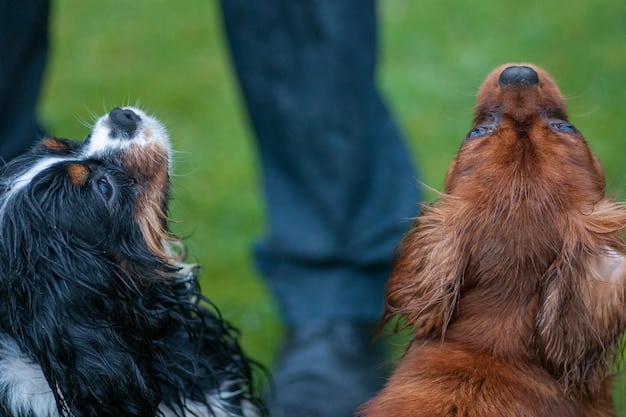
- Keep initial meetings short and sweet.
- Ensure each dog has personal space.
- Watch for signs of stress (whale eye, stiff body posture).
- End the interaction on a positive note.
Gradual introductions can help build positive associations with other dogs, making park visits much smoother.
Starting slow and controlled is preferable to overwhelming them, leading to an eventual explosion.
Reading Dog Body Language
Understanding dog body language is crucial for preventing conflicts. Dogs communicate through a complex combination of postures, facial expressions, and vocalizations. Being able to interpret these cues can help you anticipate and address potential problems.
Signs of Playful Behavior
Playful behavior includes loose body posture, wagging tail, play bows, and bouncy movements. These are indicators that the interaction is positive and friendly.
Signs of Stress or Aggression
Stress or aggression can manifest through stiff body posture, whale eye (showing the whites of the eyes), growling, snapping, or excessive barking. Recognizing these signs is vital for preventing escalations.
- Separate dogs immediately if you see signs of aggression.
- Distract dogs showing signs of stress.
- Communicate with other owners.
Prompt intervention can prevent a minor disagreement from becoming a full-blown fight.
The more knowledgeable you are about a dog’s body language, the better prepared you will be to deal with many difficult situations.
Managing Play Styles
Not all dogs play the same way. Some dogs enjoy rough-and-tumble play, while others prefer gentle interactions. Mismatched play styles can sometimes lead to conflict. Some common play styles include wrestling and chasing one another.
Understanding Different Play Preferences
Understanding your dog’s play style and recognizing the play styles of others is essential. If your dog is overwhelming others or being overwhelmed, intervention may be necessary.
Intervention Techniques
Intervention can take many forms, from calling your dog away to physically separating them. The goal is to redirect the energy and prevent unproductive or unsafe interactions.
- Call your dog away for a brief time-out.
- Redirect their attention with a toy or treat.
- Communicate with other owners about play styles.
Effective intervention can help maintain a balanced and harmonious play environment.
Knowing the right time to step in is paramount.
What to Do in Case of a Fight
Despite best efforts, dog fights can and do happen. Knowing how to respond safely and effectively can minimize injuries and prevent escalations. Never get in the middle of dogs fighting.
Safe Separation Techniques
The safest way to separate fighting dogs is often with a water hose or by making a loud noise. Avoid physically inserting yourself if possible, as you could be bitten.
Post-Fight Assessment
After a fight, assess your dog (and yourself) for injuries. Even minor wounds should be inspected by a vet to prevent infection. It’s important to consult with a veterinarian or a professional trainer following any intense event.
- Check for any visible wounds or limping.
- Monitor your dog for signs of shock.
- Consult a veterinarian promptly.
Prompt assessment and care can prevent long-term complications. It should come as no surprise that a dog park fight can cause much trauma to all parties.
Even so, remaining calm in the moment can defuse it.
Responsible Dog Ownership
Ultimately, dog park etiquette boils down to responsible dog ownership. This includes being proactive, attentive, and willing to learn. A responsible owner prioritizes the well-being of their dog and others.
Being an Attentive Owner
An attentive owner is always watching their dog, ready to intervene if needed. They understand their dog’s behavior and can recognize signs of stress or aggression early on.
Continuous Learning
Dog behavior is complex, and there is always more to learn. Staying informed about training techniques, social cues, and park safety can help you be a better owner and advocate for your dog.
- Read books and articles on dog behavior.
- Attend workshops or seminars.
- Consult with professional trainers or behaviorists.
Continuous learning helps you adapt to new challenges and keep your dog safe and happy.
Responsible ownership ensures a safe and enjoyable experience for everyone.
| Key Point | Brief Description |
|---|---|
| 🐶 Training | Basic commands like recall and sit are crucial. |
| 🐕 Socialization | Early and controlled introductions to other dogs. |
| 🗣️ Body Language | Understand signs of play, stress, or aggression. |
| 🛡️ Intervention | Know when and how to safely separate dogs. |
Frequently Asked Questions
▼
Your dog should be up-to-date on core vaccinations, including rabies, DHPP (distemper, adenovirus, parvovirus, and parainfluenza), and Bordetella (kennel cough). Consult your vet for specific recommendations based on your dog’s age and health.
▼
Allow dogs to approach each other slowly and sniff. Watch for relaxed body language, and keep initial interactions brief, intervening if either dog shows signs of discomfort or aggression. Don’t rush the process.
▼
If another dog attempts to bully your dog, calmly remove your dog from the situation. Communicate to the other owner, asking them to control their dog. If the behavior continues, consider leaving the park.
▼
Toys and treats may cause resource guarding or conflicts. If you choose to bring them, monitor your dog closely and be prepared to remove them if issues arise. Use treats judiciously and responsibly.
▼
Signs of stress include tucked tail, pinned ears, whale eye (showing whites of eyes), lip licking, yawning, panting, and attempts to hide or escape. If you notice these, remove your dog to calm down.
Conclusion
Practicing good dog park etiquette is essential for a positive experience. From pre-park training and socialization to understanding dog body language and being a responsible owner, these steps ensure a safe and enjoyable environment for all. By prioritizing safety, respect, and continuous learning, you and your furry friend can make the most of your dog park adventures.


